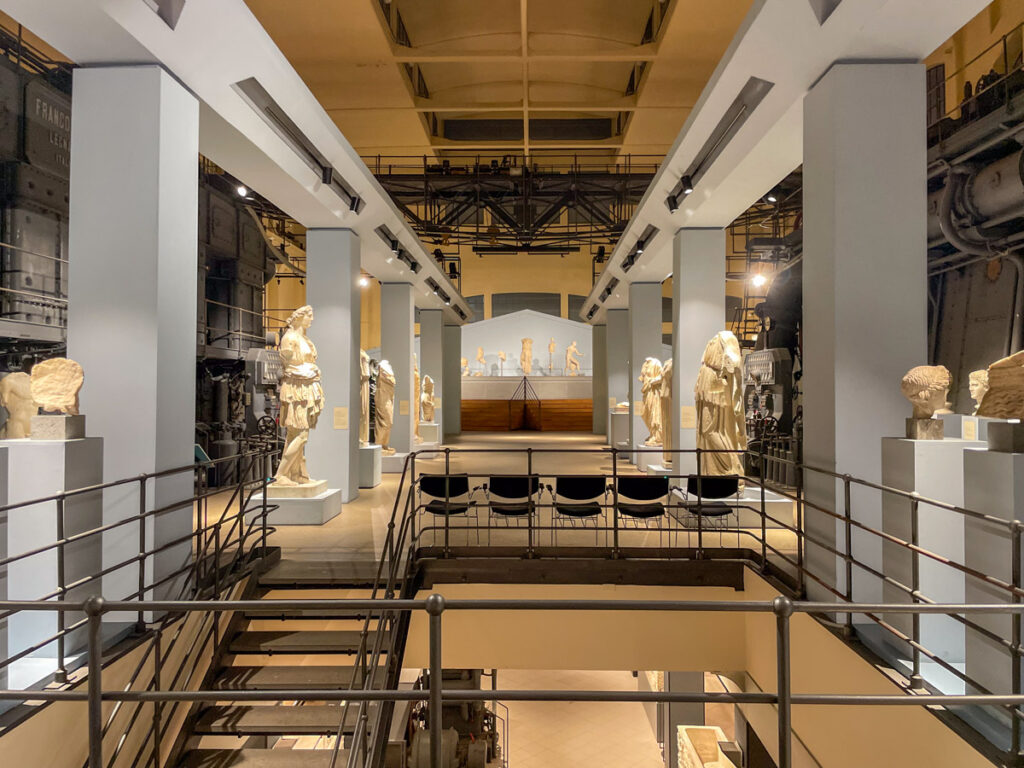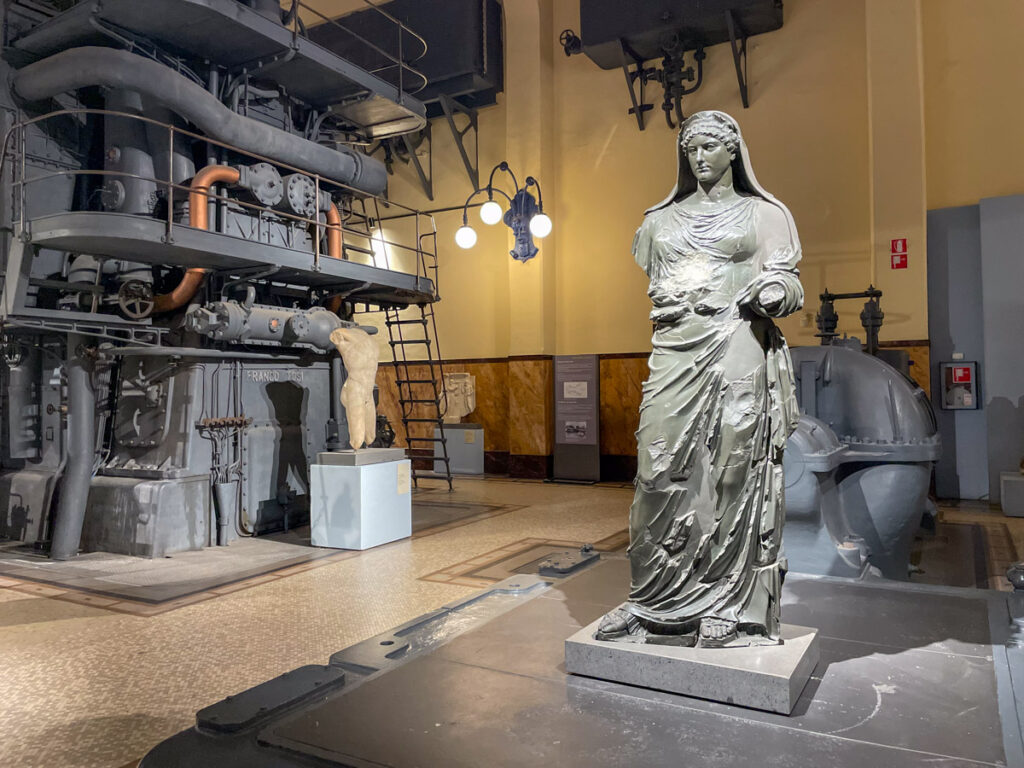Located in a thermal power plant from 1912, the Centrale Montemartini is an extraordinary example of converting an industrial archaeology building into an ancient art museum. Since 1997, the Centrale Montemartini has been a unique destination that offers a fascinating blend of ancient Roman sculptures and industrial history.
Table of Contents
Centrale Montemartini: The Building and Its History
The Centrale Montemartini museum is in the Ostiense neighbourhood of Rome, on the banks of the Tiber River. This area was once a bustling industrial district. The building that now houses the museum was previously a thermal power plant that provided electricity to the city of Rome.
PLAN YOUR TRIP TO ROME
Save money on entrance fees and transportation costs with the Roma Pass. This City Card offers free entry to two attractions, as well as discounts at other museums and archaeological sites, including the Colosseum, the Roman and Imperial Forums, the Capitoline Museums, the Ara Pacis and other must-see.
To stay connected in Italy, remember to buy an Airalo eSim online, with data and phone coverage for your trip to Rome.
The power plant dates back to 1912. In the 1930s, it was updated with two diesel engines and underwent some renovations following the technological advancements of the time. However, in the 1950s, it fell into disuse. After being abandoned for nearly three decades and turning into a relic of industrial archaeology, it was restored in the 1990s.
Architect Francesco Stefanori had the audacious idea of transforming it into a museum of ancient art. The Capitoline Museums, one of the most prominent museums in Rome, carried out the conversion.
Initially, in 1997, a temporary exhibition was set up. There were just ancient art objects, such as Roman statues in white marble, displayed in front of cast iron machinery. The idea was well-received, and the exhibition became permanent.

The Permanent Collection of Centrale Montemartini
The Centrale Montemartini hosts a remarkable collection of ancient Roman sculptures and artefacts. The collection comprises statues of emperors, gods, and other important figures from ancient Rome, previously exhibited in the Capitoline Museums.
What sets this museum apart is the unique way it displays the ancient sculptures alongside the industrial machinery. The power plant machinery is still in its original place. Showcased alongside the sculptures, it creates an intriguing contrast between ancient art and modern technology, ancient Roman archaeology and industrial archaeology.
The museum visit route starts with the ground floor, showcasing the art of the oldest republican Rome. The collection includes masterpieces such Roman tomb painting. Or the statue of the Togato Barberini, which portrays an old patrician holding the portraits of his ancestors.
The Engine Room
The heart of the exhibition is the Engine Room, located on the first floor of the building. Climbing the stairs, you see the two large, black, imposing diesel engines. In front of them are many ancient white marble heads and statues of gods, goddesses, and emperors. These Roman artworks were once stored in the Capitoline Museums. Today, have found a permanent home in the Centrale Montemartini.
The contrast between the heavy black machinery and the elegant white ancient statues is stunning. The disruptive installation plays on thematic contrast, highlighting the ancient and modern, beauty and strength, black and white, elegance and grace against power and noise.
Roman Artworks
The most significant work is undoubtedly the Musa Polymnia, wrapped in her cloak, with her absorbed and timeless expression. However, also the statue of the satyr Marsyas hanging to be skinned alive can shake the beholder’s soul. According to the myth, Marsyas dared to challenge Apollo in music and was defeated.
Crepereia Tryphaena: the Young Bride with the Doll
Near the entrance, the main attraction is the tomb of the young girl Crepereia Tryphaena. She was a young bride, or just engaged but died before her wedding day. Her peculiarity is that she was buried with her doll. This doll resembles a modern-day Barbie doll, and it has a small wedding ring on its finger.
The Train of Pius IX
On the ground floor, a section recently set up and somewhat separate from the rest of the museum displays Pope Pius IX’s train. On the mid-19th century, the pope wanted the new railway technology to be available in the Papal States.
The wagons on display are very luxurious and bear the mark of Pius IX. The first journey of this train took place in 1859 along the Pio-Latina railway. It went as far as Ceprano, on the border of the Bourbon kingdom. However, shortly after the unification of Italy, the train was decommissioned.
Temporary Exhibitions at the Centrale Montemartini
The Centrale Montemartini museum not only houses a permanent collection but also hosts temporary exhibitions. These exhibitions range from photography to insights into ancient and modern art.
For instance, the exhibit displayed during my visit, ‘Architetture Inabitabili’ (Uninhabitable Architecture) exhibition, offered a fresh perspective on architecture. It aimed to discover a conception of architecture that differs from the one commonly associated with housing functionality.

Useful Information to Visit the Centrale Montemartini
The museum is open for visitors from Tuesday to Sunday. You can purchase tickets online, in a bundle with Capitoline Museums, or buy them in person at the ticket counter.
How to Get to Centrale Montemartini
The Centrale Montemartini Museum is in Via Ostiense, right at the exit of the Garbatella subway station. If you prefer walking, it’s just a short distance from Ostiense railway station.
Other examples of industrial archaeology are behind the power station, such as the gasometer. These structures serve as tangible reminders of the city’s growth and development. Rome’s industrial hub was here at the start of the 20th century and gradually became part of the expanding city.
Centrale Montemartini
Via Ostiense, 106, 00154 Roma
The Centrale Montemartini museum is a must-visit destination to discover ancient Roman culture or industrial history. The museum provides a unique experience unlike any other museum in Rome. The juxtaposition of the industrial machinery and the ancient Roman sculptures creates an eerie and fascinating unique atmosphere. So, if you find yourself in Rome, take some time to visit this fascinating museum. After exploring the unique blend of ancient art and industrial history, come back here and let a comment about Centrale Montemartini.
